|
|
Post by snowmom on Feb 12, 2015 16:45:02 GMT -5
hornseeker, check out cocolithophores, forms of small algae, most seem to have the basic doughnut shape, wonder what a section of your rock under a microscope would show us. getting even more interesting as we go along.
|
|
jamesp
Cave Dweller 
Member since October 2012
Posts: 36,612
|
Post by jamesp on Feb 12, 2015 18:25:40 GMT -5
They are so consistent in size. Thinking fossil something.
|
|
batt
off to a rocking start

Member since May 2016
Posts: 1 
|
Post by batt on May 31, 2016 2:10:48 GMT -5
H hi
|
|
Fossilman
Cave Dweller 
Member since January 2009
Posts: 20,723 
|
Post by Fossilman on May 31, 2016 10:05:19 GMT -5
All the oolite I see is much coarser... and if it is oolite, it almost seems like it must be metamorphosed?? Its really hard. Here's an example... not sure of scale...  I have a rough of Oolite,didn't like it at first,till I cut it... 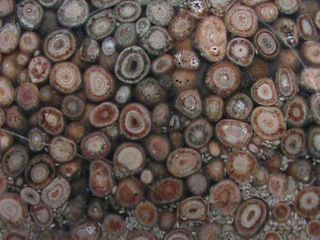 |
|
Fossilman
Cave Dweller 
Member since January 2009
Posts: 20,723 
|
Post by Fossilman on May 31, 2016 10:11:46 GMT -5
This one looks impactified, has a few metal/pyrite bits, looks like it recrystalized around the center breccia. Lots going on. 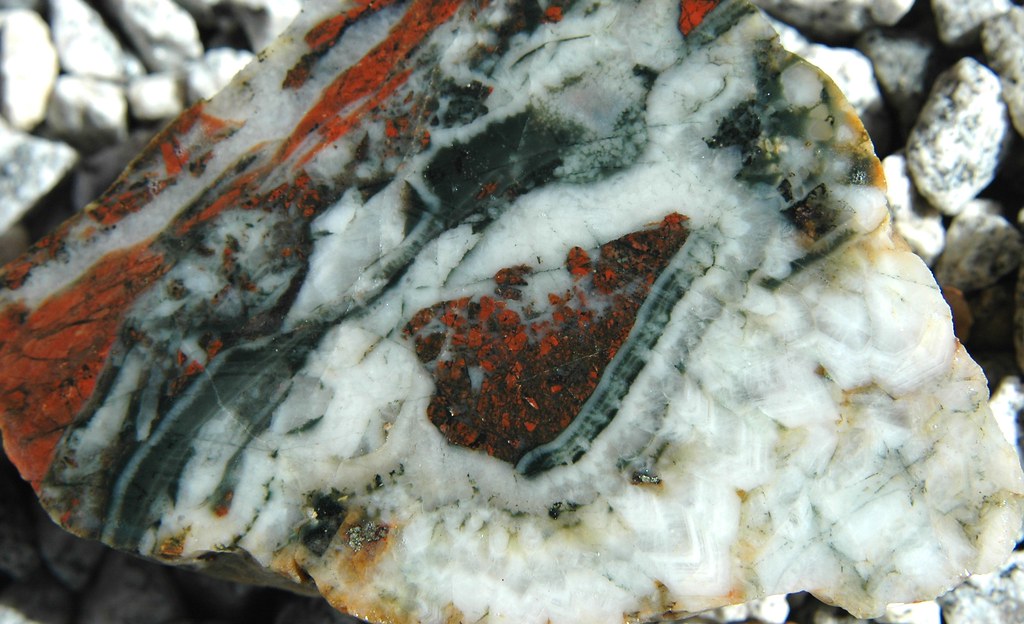  This rock has seen some hell and than some....LOOK at the healed fracture areas and the un-stablized waterline that did exist....The un-even levels of formation tells a guy it was going through a rough time,when it was being formed,with the minerals being added throughout the millions of years.... Kind of cool to think about! |
|
Deleted
Deleted Member
Member since January 1970
Posts: 0
|
Post by Deleted on May 31, 2016 10:18:29 GMT -5
fantastic5 external photos, and a couple of others, perhaps chrome diopside and green basalt ? 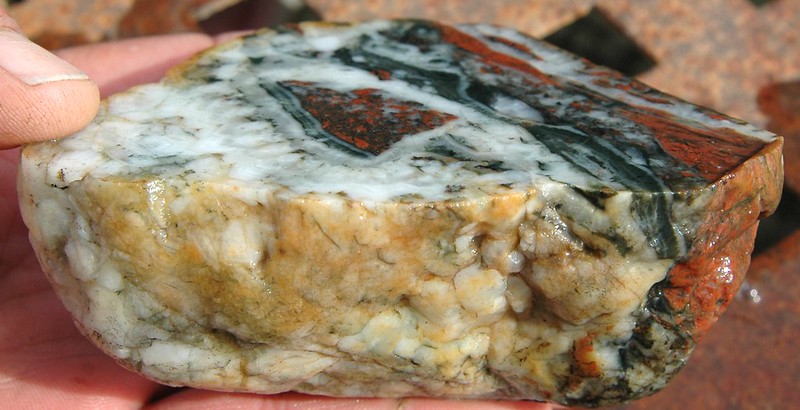 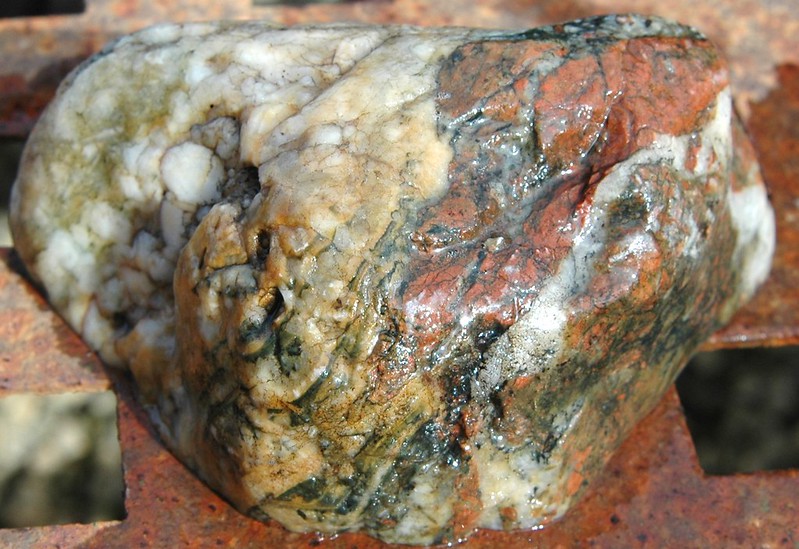 chrome diopside ? crystal quartz scratches it, supposed to be mohs 6 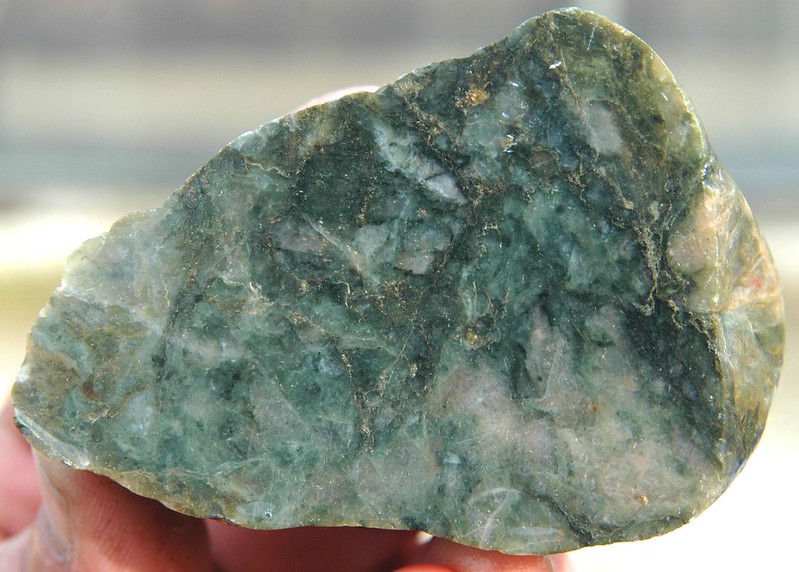 maybe basalt ? 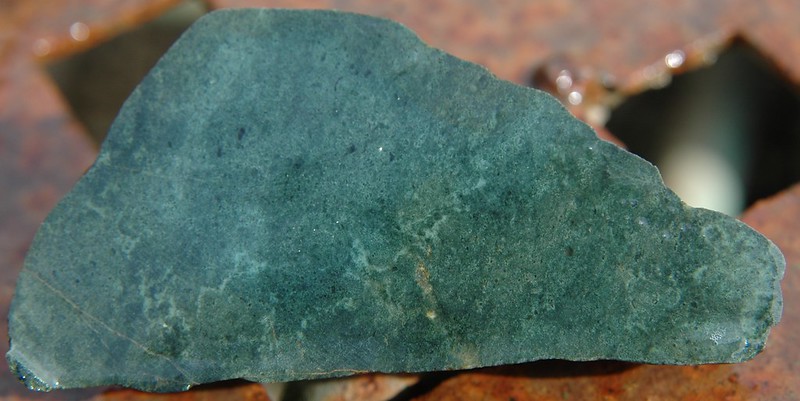 Top one looks like a atandard agate quartz to me. The little breccia area seem like any other breccia.. The last one, what does the outside look like? Could be jade or basalt as you said. |
|
Fossilman
Cave Dweller 
Member since January 2009
Posts: 20,723 
|
Post by Fossilman on May 31, 2016 10:19:09 GMT -5
I have no idea if it would related to this thread, but we found a rock on the Yellowstone the other day that is completely fascinating... I am going to try and get some good macros of it tonight and post them... the entire rock is composed of tiny (relatively speaking... maybe 1/2 mm...) spheres... ranging in colors from cream to red if I remember right... really fascinating... pics tonight! (I hope, Im trying to remember where it is!!) I don't want to get off topic on this page...But Hornseeker we need to get a page going on the weird finds on the Yellowstone River,let people know,it's not just about the Montana moss agates...Found in that river... I have some crazy stuff coming out of it... |
|
jamesp
Cave Dweller 
Member since October 2012
Posts: 36,612
|
Post by jamesp on May 31, 2016 16:32:23 GMT -5
@shotgunner I.D. on Great Lakes rocks are a challenge. Got a nice box from snowmom and Jugglerguy. Rob's were dolomite and unakite. snowmom 's kinda blew the mind. |
|
|
|
Post by fernwood on Jun 1, 2016 21:45:43 GMT -5
Agree that there are many rocks around the Great lakes that should not be there. A lot of what I am finding has been identified by local geologists. Because of the geology of the area, the glaciers, volcanoes, ancient lakes, and violent metamorphic changes, one never knows what they will find. There are a lot of unique rocks for sure.
|
|
landwave
off to a rocking start

Member since November 2016
Posts: 4 
|
Post by landwave on Nov 19, 2016 14:22:03 GMT -5
I took the impactite and other specimens that snowmom sent me to a geologist friend of mine in the University of Tennessee at Chattanooga. I also took him a piece from the large rock that jamesp has. He was very impressed with the specimens and slabs (I cut a few before going), but he doesn't think the x-ray diffraction will be of any help for the impactite specimens as they are made up of multiple minerals. He will be doing thin sections and using microscopy and polarization microscopy to determine the make up. We spent quite a bit of time looking at the slabs through the stereo microscope. Under magnification they are riddled with metal, but unfortunately with just a cursory exam, Wayne thinks it is all pyrite, rather than nickel. I gave him all that you sent labelled, but only took a few pictures as they were not all cut yet. Here are a few pictures of the slabs that he has. This first one as soon as he saw the bright yellow spot he asked me if I had a Geiger counter, to which I had to say no. He said he would check it as part of his analysis. Under microscopy he could see section that appeared to be actinolite. It also had a few absolutely clear quartz tear drops. They could not be seen with the naked eye, but really cool none the less. And yes, I tried to shoot a cell phone picture through the eye piece of the microscope, but to no avail. You will just have to take my word on it.   This one really interested him because of the 'pulled glass' look to lighter spots:  Now for the one that had them scratching their heads. It is the one that you labelled as @shotgunner 's guess at kimberlite. According to the geologists, you cannot get perfect spheres unless they form suspended in air as droplets. Also they couldn't think of anything that is both red and green. Under magnification these have red droplets with green rings, green with red rings, green and red swirled in one drop, black circles, green with black rings....well you get the idea. This is the one that they are hoping to separate the red and green spheres and put through the x-ray diffraction to see what the elemental composition is.   Have you found any more of these?  ? I will update again once I hear back from Wayne. |
|
landwave
off to a rocking start

Member since November 2016
Posts: 4 
|
Post by landwave on Nov 19, 2016 15:16:04 GMT -5
I took the impactite and other specimens that snowmom sent me to a geologist friend of mine in the University of Tennessee at Chattanooga. I also took him a piece from the large rock that jamesp has. He was very impressed with the specimens and slabs (I cut a few before going), but he doesn't think the x-ray diffraction will be of any help for the impactite specimens as they are made up of multiple minerals. He will be doing thin sections and using microscopy and polarization microscopy to determine the make up. We spent quite a bit of time looking at the slabs through the stereo microscope. Under magnification they are riddled with metal, but unfortunately with just a cursory exam, Wayne thinks it is all pyrite, rather than nickel. I gave him all that you sent labelled, but only took a few pictures as they were not all cut yet. Here are a few pictures of the slabs that he has. This first one as soon as he saw the bright yellow spot he asked me if I had a Geiger counter, to which I had to say no. He said he would check it as part of his analysis. Under microscopy he could see section that appeared to be actinolite. It also had a few absolutely clear quartz tear drops. They could not be seen with the naked eye, but really cool none the less. And yes, I tried to shoot a cell phone picture through the eye piece of the microscope, but to no avail. You will just have to take my word on it.   This one really interested him because of the 'pulled glass' look to lighter spots:  Now for the one that had them scratching their heads. It is the one that you labelled as @shotgunner 's guess at kimberlite. According to the geologists, you cannot get perfect spheres unless they form suspended in air as droplets. Also they couldn't think of anything that is both red and green. Under magnification these have red droplets with green rings, green with red rings, green and red swirled in one drop, black circles, green with black rings....well you get the idea. This is the one that they are hoping to separate the red and green spheres and put through the x-ray diffraction to see what the elemental composition is.   Have you found any more of these?  ? I will update again once I hear back from Wayne. |
|
landwave
off to a rocking start

Member since November 2016
Posts: 4 
|
Post by landwave on Nov 19, 2016 15:16:40 GMT -5
|
|
landwave
off to a rocking start

Member since November 2016
Posts: 4 
|
Post by landwave on Nov 19, 2016 15:52:26 GMT -5
|
|
metalsmith
Cave Dweller 
Member since October 2012
Posts: 1,537
|
Post by metalsmith on Nov 20, 2016 7:52:48 GMT -5
I'm not ready to discount the chance that some of it is nickel. Under the stereo scope I could see at least two different colors of 'pyrite' near each other on more than one of the slabs. Honestly I think Wayne was using the same approach we do in medicine. Always expect the most common and you don't start considering the rare until you disprove the common. There may well be nickel, but there are at least three different 'colours' of pyrite: Iron pyrite Chalcopyrite Pyrrhotite Of course there's a number of different proportional combinations of the above minerals too. |
|
metalsmith
Cave Dweller 
Member since October 2012
Posts: 1,537
|
Post by metalsmith on Nov 20, 2016 8:01:29 GMT -5
Nickel in hydrochloride acid makes green nickel chloride. Carcinogenic so be careful. If it is nickel that gives Chrysoprase it's green colour, maybe this is something to pay heed to. Mindat provides it is a hydrated silicate (i.e. no Cl) However other sources state that evidence suggest that it is the Ni is the carcinogen: "exposures to nickel compounds are associated with increased nasal and lung cancer incidence, both in mostly occupational exposures" - so we should be (more) careful. |
|
metalsmith
Cave Dweller 
Member since October 2012
Posts: 1,537
|
Post by metalsmith on Nov 20, 2016 8:10:00 GMT -5
Now for the one that had them scratching their heads. It is the one that you labelled as @shotgunner 's guess at kimberlite. According to the geologists, you cannot get perfect spheres unless they form suspended in air as droplets. Also they couldn't think of anything that is both red and green. Under magnification these have red droplets with green rings, green with red rings, green and red swirled in one drop, black circles, green with black rings....well you get the idea. This is the one that they are hoping to separate the red and green spheres and put through the x-ray diffraction to see what the elemental composition is. They need to get their thinking caps on: tourmaline is classic red-green (watermelon) and other minerals e.g. ruby-zoisite and different garnets also, the colours being reflective of different redox states of iron. I'm sure there is something else in my mind crawling round hiding under a stone somewhere about red/green halos. I'll see if I can't swat it out of the air at some point. Ah - a later post suggests Olivine; this was at the root of my thought, but needed something further... Dunite is hardly red, but an earlier link points to a red derivative of Olivine. |
|
metalsmith
Cave Dweller 
Member since October 2012
Posts: 1,537
|
Post by metalsmith on Nov 20, 2016 8:20:51 GMT -5
They are so consistent in size. Thinking fossil something. Oolites are concretions formed from a seed-particle. As grains of sand are generally the same size, they form oolites of the same size due to relatively constant exposure (as their neighbours) to solutions that with evaporation become super-saturated and look to precipitate out onto the nearest seed. Oolites are all typically identical in size. Not ruling out theory of biological origin, but not always necessarily biological. |
|
jamesp
Cave Dweller 
Member since October 2012
Posts: 36,612
|
Post by jamesp on Nov 20, 2016 9:35:00 GMT -5
They are so consistent in size. Thinking fossil something. Oolites are concretions formed from a seed-particle. As grains of sand are generally the same size, they form oolites of the same size due to relatively constant exposure (as their neighbours) to solutions that with evaporation become super-saturated and look to precipitate out onto the nearest seed. Oolites are all typically identical in size. Not ruling out theory of biological origin, but not always necessarily biological. Interesting. Fossil patterns difficult to discriminate from chemically reacted patterns. |
|
metalsmith
Cave Dweller 
Member since October 2012
Posts: 1,537
|
Post by metalsmith on Nov 20, 2016 11:50:44 GMT -5
Oolites are concretions formed from a seed-particle. As grains of sand are generally the same size, they form oolites of the same size due to relatively constant exposure (as their neighbours) to solutions that with evaporation become super-saturated and look to precipitate out onto the nearest seed. Oolites are all typically identical in size. Not ruling out theory of biological origin, but not always necessarily biological. Interesting. Fossil patterns difficult to discriminate from chemically reacted patterns. Sometimes those 'sands' may be shelly, especially around coral reef environments; it is pretty much a pre-cursor to having the super-saturated calc solution. As the reef is broken down the particles become finer and finer, having a larger surface area, dissolving to the point of saturation and then with increased temperature - diurnal variation - to precipitate out, since CaCO3 dissolution is decreased by warm temperatures. |
|
jamesp
Cave Dweller 
Member since October 2012
Posts: 36,612
|
Post by jamesp on Nov 20, 2016 12:58:56 GMT -5
metalsmithReaching past my vocabulary, add chemistry and I am lost lol.
|
|